


Col. George Newcom still revealed the flinty quality that tamed the wilderness when he sat for this daguerreotype in 1852 at the age of 81. Dayton was already a bustling town, with a classic courthouse that ranked among the country’s finest structures.
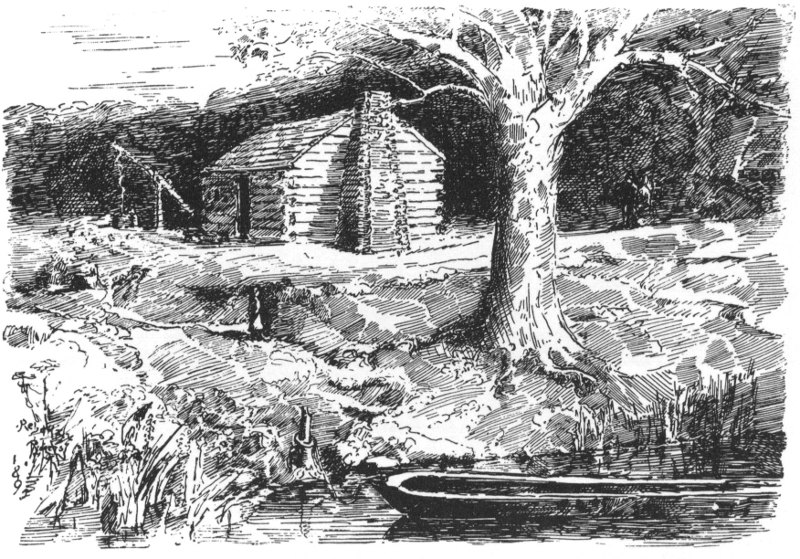
Newcom’s first cabin, of round logs instead of square-hewn logs, later served as kitchen for the structure now in Carillon Park. Smaller building disappeared many years ago. (Etching courtesy of Otterbein Press.)
By the mid-1700s, a few intrepid men from “back East” had explored the land of the Miami Indians. Upon their return to the seaboard these scouts sat about their firesides painting attractive word-pictures of the territory beyond the Alleghenies. It was “rich, level and well-timbered.” Clover, rye and bluegrass were abundant, along with enough small game, deer and wild turkey to keep any number of settlers from want. The countryside, in the words of one report, was “just waiting to be tickled with the hoe that it might laugh with a harvest.”
It was to be almost another half-century, however, before anyone packed up his wife, musket and hoe and established a home in these fertile lands of legend. The Miamis—a tribe of the Algonquin family in powerful league with the Shawnees, Wyandots, Potawatomies and the Ottawas—were determined to keep the white man off the prime hunting grounds that lay between the Great and Little Miami rivers. They frequently crossed the Ohio to raid threatening settlements in Kentucky territory, and the doughty Kentuckians in return made bloody sorties into the Indians’ Miami Valley. Two of the fiercest encounters were fought on the triangle of land where the Mad River meets the Great Miami.

1896 view of the Tavern on Monument Avenue, four years after it was moved there from the southwest corner of Main and Monument.
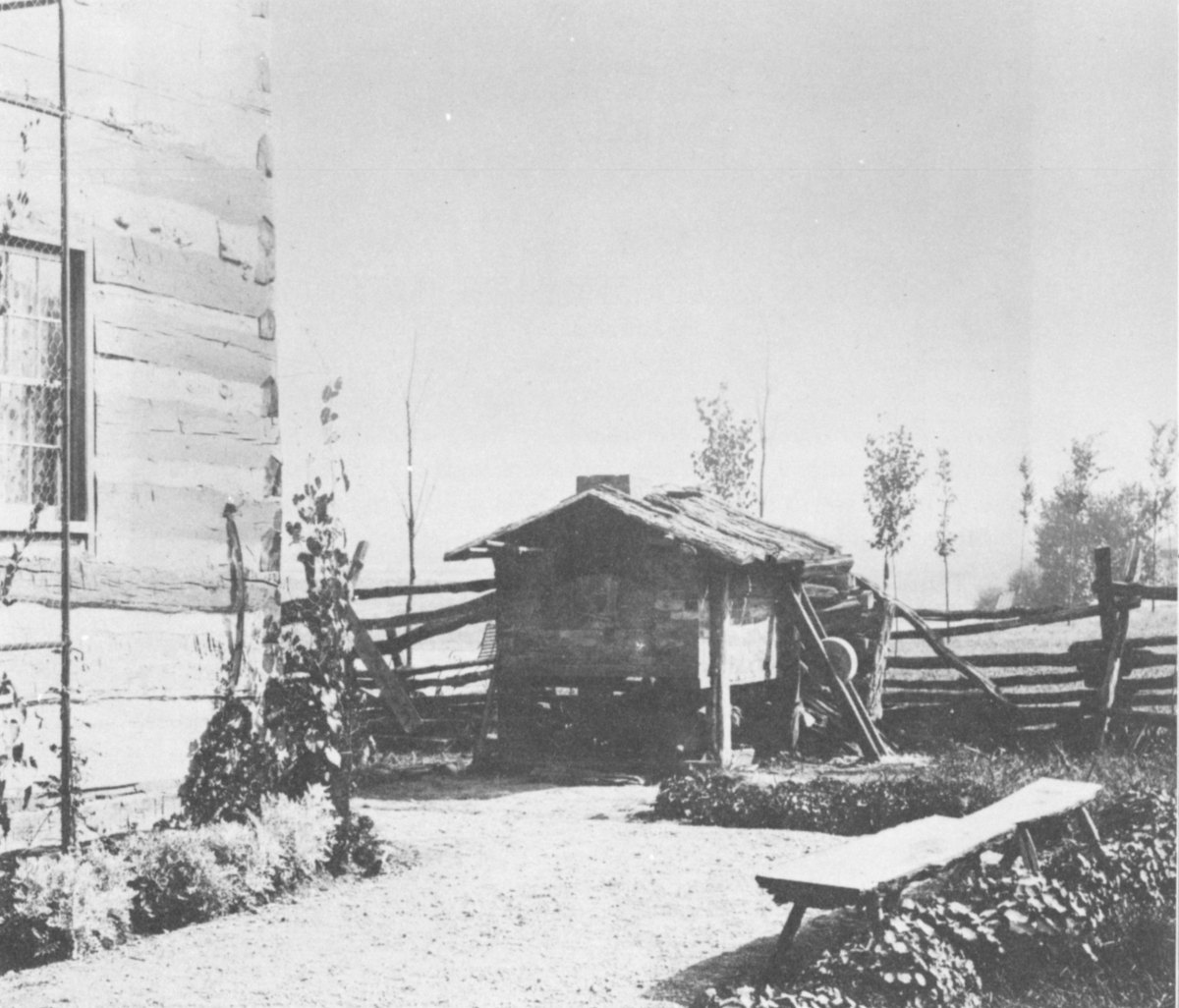
Late nineteenth century photograph of Tavern’s yard shows brick oven, split-log bench and primitive sharpening wheel.
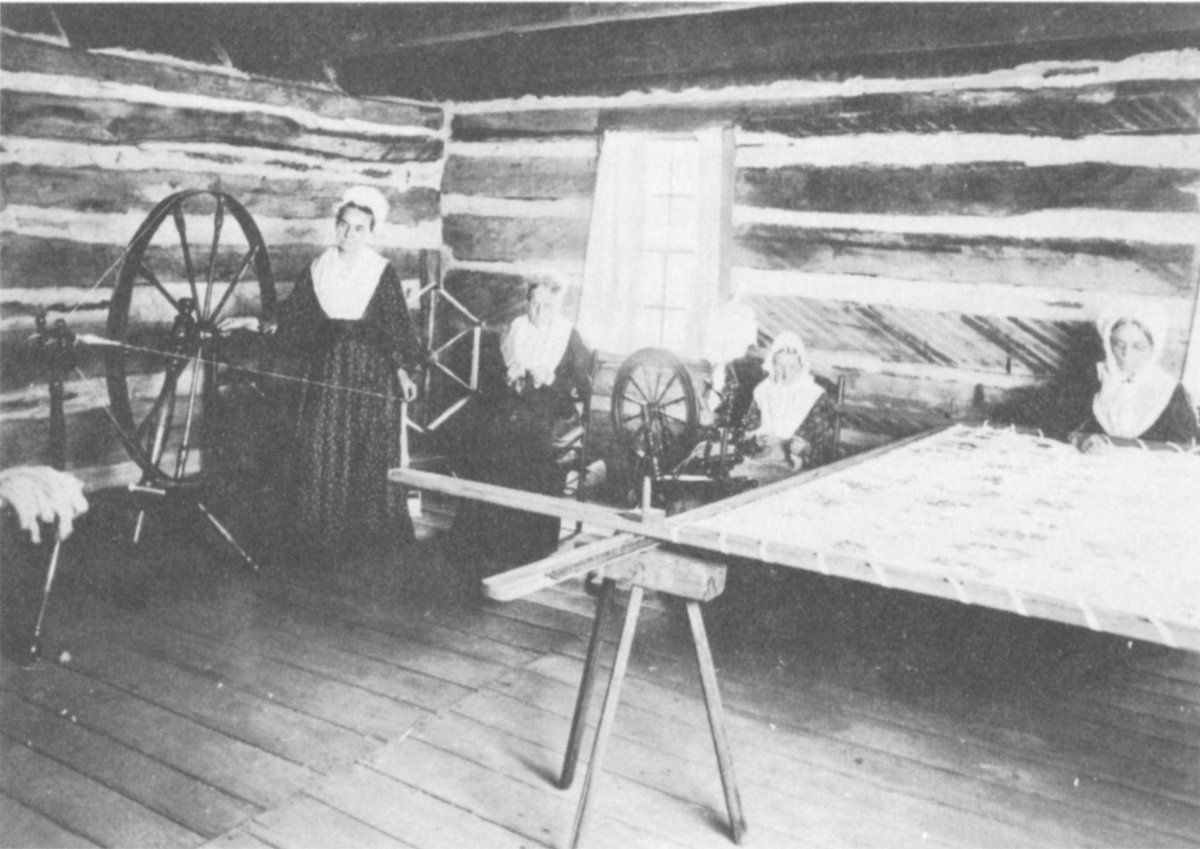
In 1896, on the hundredth anniversary of Dayton’s founding, these women donned pioneer dress and demonstrated the skills of their mothers and grandmothers. The picture, taken in one of the two upstairs rooms at Newcom Tavern, shows spinning, knitting, use of the flax wheel and quilting.
Things were desperate—hardly secure for family life and farming—until that able general, “Mad Anthony” Wayne, led a force of 3600 daring men into Ohio country. The eventual surrender of the Miamis (led by Chief Little Turtle) resulted in the Treaty of Greenville, and the end of the strife that had kept the Valley a wilderness. The treaty was signed in 1795, a little over a decade after Ohio, as part of the Northwest Territory, had come under control of the United States, and Congress had authorized sale of the land.
In the year of the treaty, Jonathan Dayton, head of a New Jersey land company which also included Generals Wilkinson and St. Clair and a 4 Colonel Ludlow, acquired the so-called “seventh and eighth ranges” between the two Miami Rivers, and employed surveyors to lay out a town site. The town was to take Jonathan Dayton’s name, although he was never to lay eyes on the holding. Ludlow (in the company of the surveyor, Daniel Cooper) was the only member of the land company to make the westward trek.
Newcom Tavern was one of the first structures to be erected in Dayton, and it is the oldest Dayton building now standing. Long a familiar landmark of Van Cleve Park, on Monument Avenue in downtown Dayton, the Tavern was moved to Carillon Park in the summer of 1964. Here, it is much more accessible to the public than it was in the congested business district, and it has the wooded setting that a frontier relic deserves.
It was in the spring of 1796 that three groups of settlers headed north from Cincinnati. One party came by flat boat, or pirogue, which was laboriously poled up the Miami. The other two groups came overland—one by wagon, the other on foot, leading packhorses and driving cattle.

Early household utensils include, on shelf at left, a hearth rotisserie and a foot warmer. Corn crusher stands in the corner and on shelf at right are various grinders, a dough board and a cypress knee in which salt was kept.
The latter party was led by Colonel George Newcom, a veteran of Wayne’s campaign against the redskins. Newcom immediately chose a lot on the southwest corner of Main and Water (now Monument Avenue) Streets, where the Newcom Manor apartments were later erected. He put up a one-room cabin of round logs as temporary shelter, then engaged one Robert Edgar to build a permanent house—18 by 22 feet, of square-hewn logs, with a loft above reached by a ladder. The small original shelter served as kitchen to the larger house for a while, but eventually was razed.
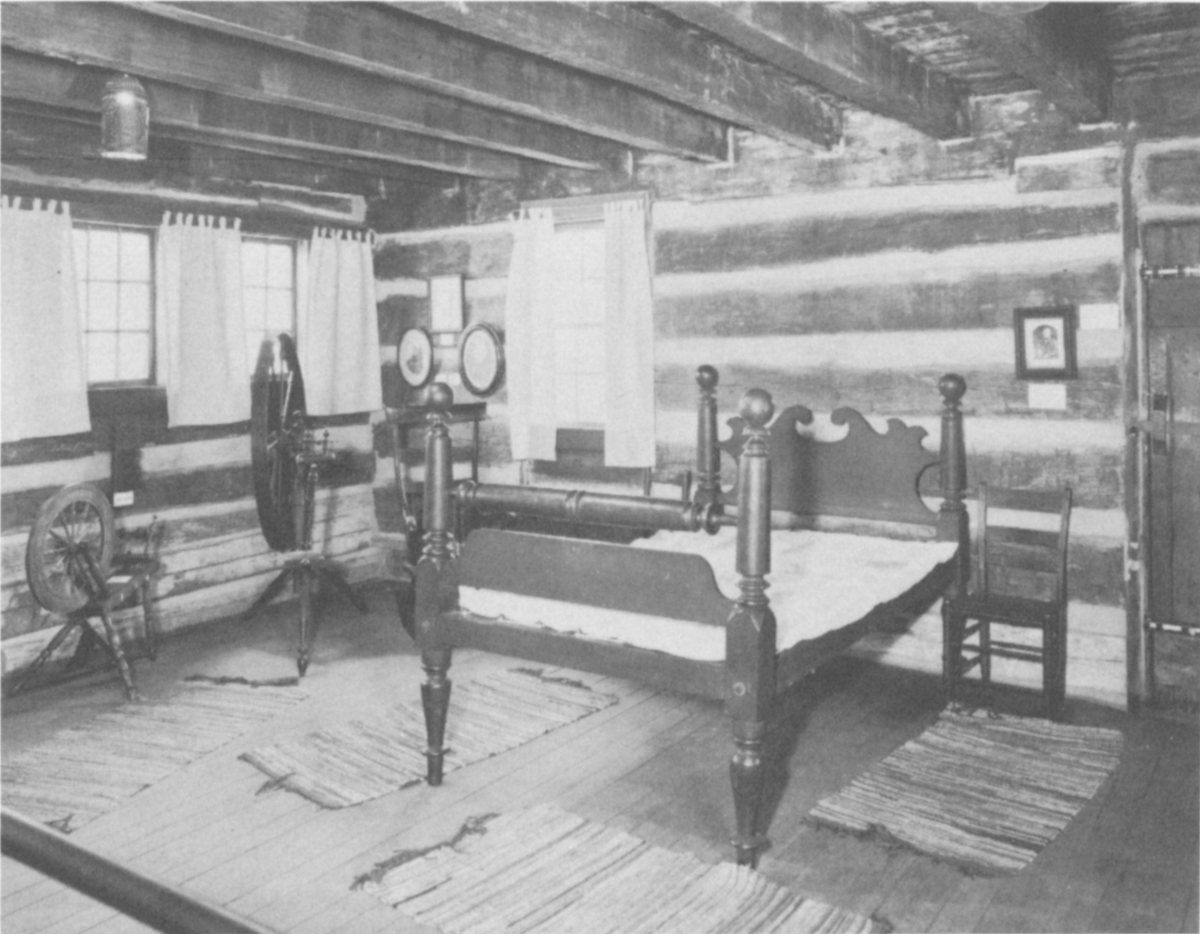
Simple furnishings and venerable logs bring extraordinary warmth and charm to this first-floor bedroom. Corn husks were used as fill for the mattress; bed was used by the Newcoms, and was probably made in Dayton.
John F. Edgar, son of Robert, left a detailed account of those early days in his book, “Pioneer Life in Dayton and Vicinity,” published in 1896. Concerning construction of the log tavern, he wrote:
“The agreement was that Newcom should pay Edgar six shillings (seventy-five cents) per day for cutting and hewing the logs for the ‘best house in Dayton,’ to front on Main and Water Streets, and Edgar for his board agreed to furnish Newcom the carcass of a deer once every week, retaining the skin. This was full payment for his board and lodging. In order to comply with this part of his contract without breaking a day’s work, my father would rise early, hide in the bushes on this side of the river at Main Street, and watch for the deer to come down to the river on the north side for their morning drink, when, choosing the best-looking one, he never failed to drop him. He would then, with his canoe, bring his week’s board across the river before breakfast....”

Main room of Newcom Tavern contains long table at which early travelers were served. Utensils in the fireplace include a griddle, pots of various types and, visible at lower left, a bread toaster that could be moved up to the hot coals by a long handle. Board at right of the fireplace holds rifle, powder horn and bullet mold. Items in the Tavern are appropriate to Dayton’s earliest years, although not all of them were actually used by the Newcom family. Fireplace facing was rebuilt with original stones, which probably came from Miami River bed.

View of the Tavern on its downtown site, from across the Miami River. Steele high school is at right, Memorial Hall at left. Picture was taken sometime between 1910 and 1918, because Memorial Hall was built in 1910 and the Engineer’s Club, built in 1918 on the southeast corner of Monument and Jefferson, is not yet in evidence.
Elsewhere in his book, Edgar tells us that Newcom was born in Ireland in 1771, and came to America with his parents in 1775. The family first settled in Delaware, then moved to the vicinity of Middletown, Pa. In 1794, Newcom and his wife, the former Mary Henderson, migrated to Cincinnati—and thence to Dayton. Of their arduous northward journey, historian Edgar wrote:
“The party led by George Newcom overland met with few difficulties as far as Fort Hamilton, the road to that place being kept in good condition by the army. From that point on, the road had been only recently surveyed by Mr. Cooper and his corps of helpers, and was in such primitive condition that it was necessary in crossing small streams to fell trees for footbridges. For the larger streams rafts were made to carry the people and the freight, the cattle and horses swimming across. All the property was carried in creels [a kind of wickerwork basket] on packhorses, the children that were too small to walk being also carried in the creels, their heads only showing. Game being plentiful the party suffered no hardship from lack of food, but the nights were cold and the hastily constructed camps afforded but little shelter, the beds being made in the open air by spreading blankets over brush. This party was about two weeks on the road.”
Edgar got his lime mortar by burning stones from the river. The size of the cabin was doubled two years later by addition of the section on the left. (The joining point is marked by the vertical logs just to the right of the present doorway.) The new house, completely whitewashed at first, became the hub for much of Dayton’s early activity. It housed the town’s first school. The first church service was held there. It served as courthouse, council chamber, store and, most colorfully, as a crossroads tavern for the wagon men and drovers who were fanning out into the lush Northwest Territory.
In addition to service as Dayton’s first tavern and trading post operator, Newcom was Montgomery county’s first sheriff and jailer, was elected to the State Senate in 1815, and succeeded Benjamin Van Cleve (one of the men who came north by flatboat) in the office of clerk of the court. The Colonel also was first president of Dayton’s first bank, and somehow found the time to serve in the War of 1812. He died in 1853 at the age of 82, having lived to see his community’s crowning glory—the stately Grecian courthouse that was dedicated in 1850, and is still standing at Third and Main.
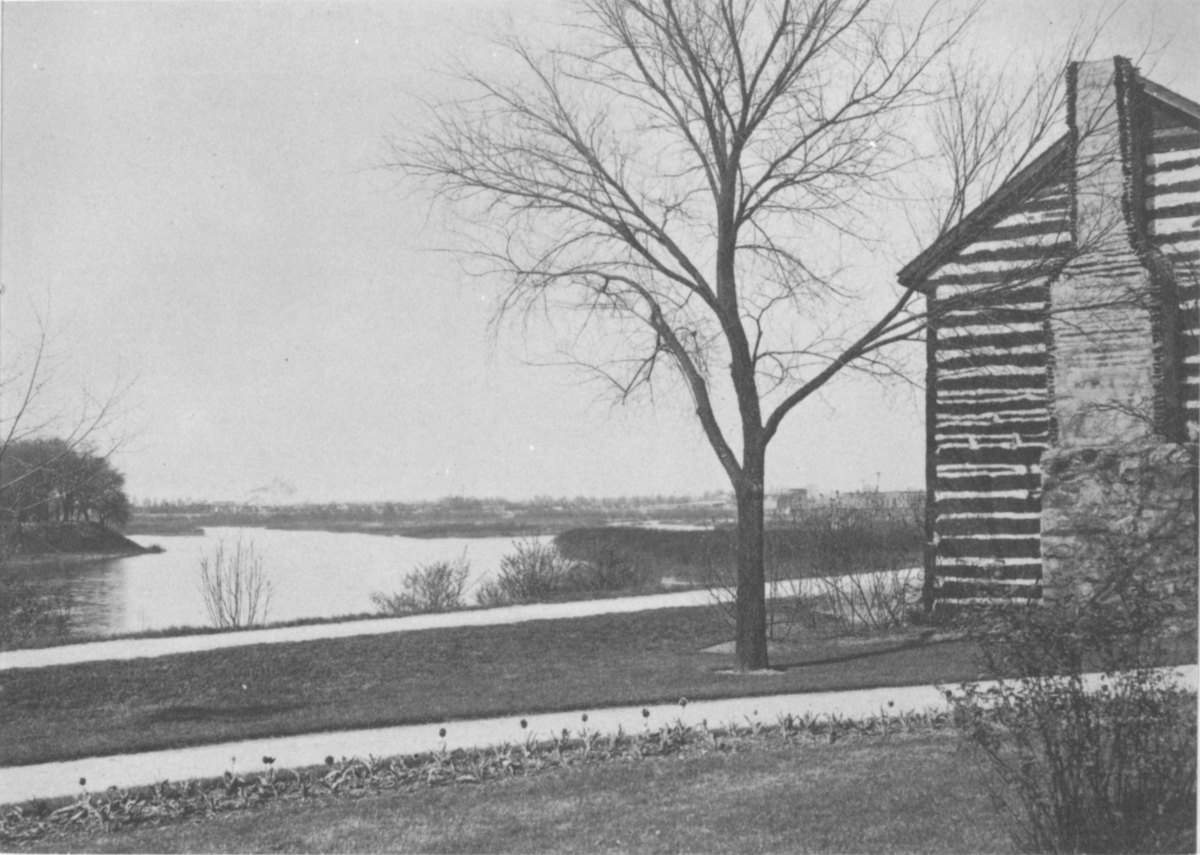
Serene view of the Tavern on its Monument Avenue site. Skirmish with Indians took place on the point of land at the left of photograph.
After Ohio achieved statehood in 1803, Montgomery county was formed. (It is named after General Richard Montgomery, who was killed in the 10 Revolutionary War attack on Quebec.) An act of Congress made Dayton the county seat in 1804, and designated George Newcom’s log house a temporary courthouse.
The Tavern was quartermaster headquarters for General Hull’s army in the War of 1812 under the command of Colonel Robert Patterson, grandfather of the founder of The National Cash Register Company, John H. Patterson.
The first “native Daytonian” was, incidentally, born in Newcom Tavern. She was Jane Newcom, daughter of the owner and his wife, Mary.

Ready for the big move from Monument Avenue to Carillon Park, in summer of 1964, Tavern stood trussed in I-beams and heavy timbers. Newcom Manor apartments, barely visible at right of photo, were built on Tavern’s original site at southwest corner of Main and Monument.
The Tavern stood on its original site almost a century. It was an inn until 1836, after which it served as a general store. The years saw many changes in the rude structure: it was plastered on the inside and weather boarded on the outside; even the shape of the roof was changed. Townspeople were generally unaware of its historic significance when, in 1894, architect Charles Insco Williams started to raze it to make way for the apartment building. Removal of the clapboards revealed the original logs. John H. Patterson, always interested in local history, had the Tavern moved at his own expense to the Monument Avenue location. The Daughters of the American Revolution raised money by public subscription 11 to have it restored, and the Montgomery County Historical Society subsequently operated it as a museum of pioneer relics.
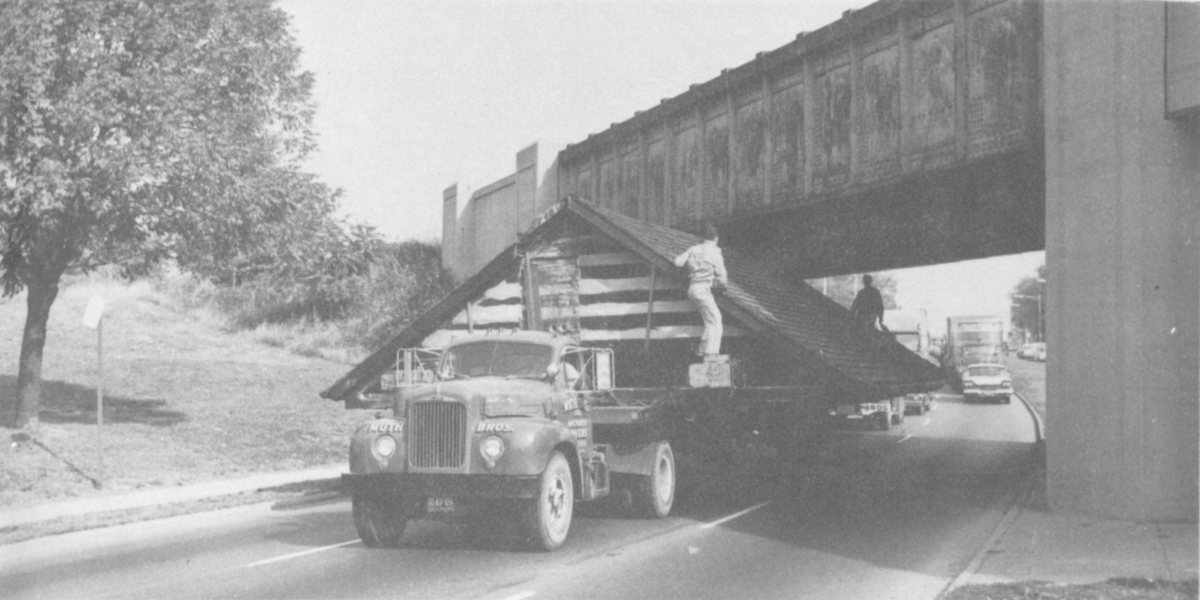
With only a couple of inches to spare, the roof of Newcom Tavern is eased through Route 25 underpass on its way to Carillon Park.
Current contents of Newcom Tavern pertain strictly to the earliest days of Dayton, without the items from later periods that were displayed at the Monument Avenue location.
We see a set of antlers, possibly from one of the deer shot by Robert Edgar during his daybreak vigils at the Miami river. A rocker and a cradle came up the river with the Thompson family, from whom the Wright brothers were descended. Among other interesting furniture are Colonel Newcom’s favorite chair, a rope bed typical of the period, a spinning wheel, and the long table which served in the tavern dining room. Pewter, odds and ends of dishes, brooms, stone jugs, a bullet mold, a corn grinder and a coffee mill are among the artifacts. An item of special curiosity is a sand box dating from the time the cabin was used as a school. The box wasn’t for play, however; pupils, lacking paper, inscribed their lessons in the smooth sand, and “erased” them after the schoolmaster’s inspection.
For the two-mile trailer trip from Monument Avenue to Carillon Park, the roof of the Tavern was removed so the structure would pass under power lines. The sides were braced with stout timbers and steel framing, and a number of termite-weakened logs were replaced. Fortunately, some weathered but sturdy logs were found in an old barn, so all of the structure retains the 1796 appearance. All in all, it was a touchy job of moving—likened by one observer to “holding a house of cards in one hand while dodging under low doorways.”

Tavern is reassembled at Carillon Park next to the stone pioneer house. Rude log houses were typical of earliest frontier construction, although stone was often used in areas where it was plentiful. Chimney design of Carillon Park’s stone house, seen in background of the photograph, shows influence of the Moravians, a religious sect that came to Ohio from North Carolina, Pennsylvania and Georgia in the early 1800s.
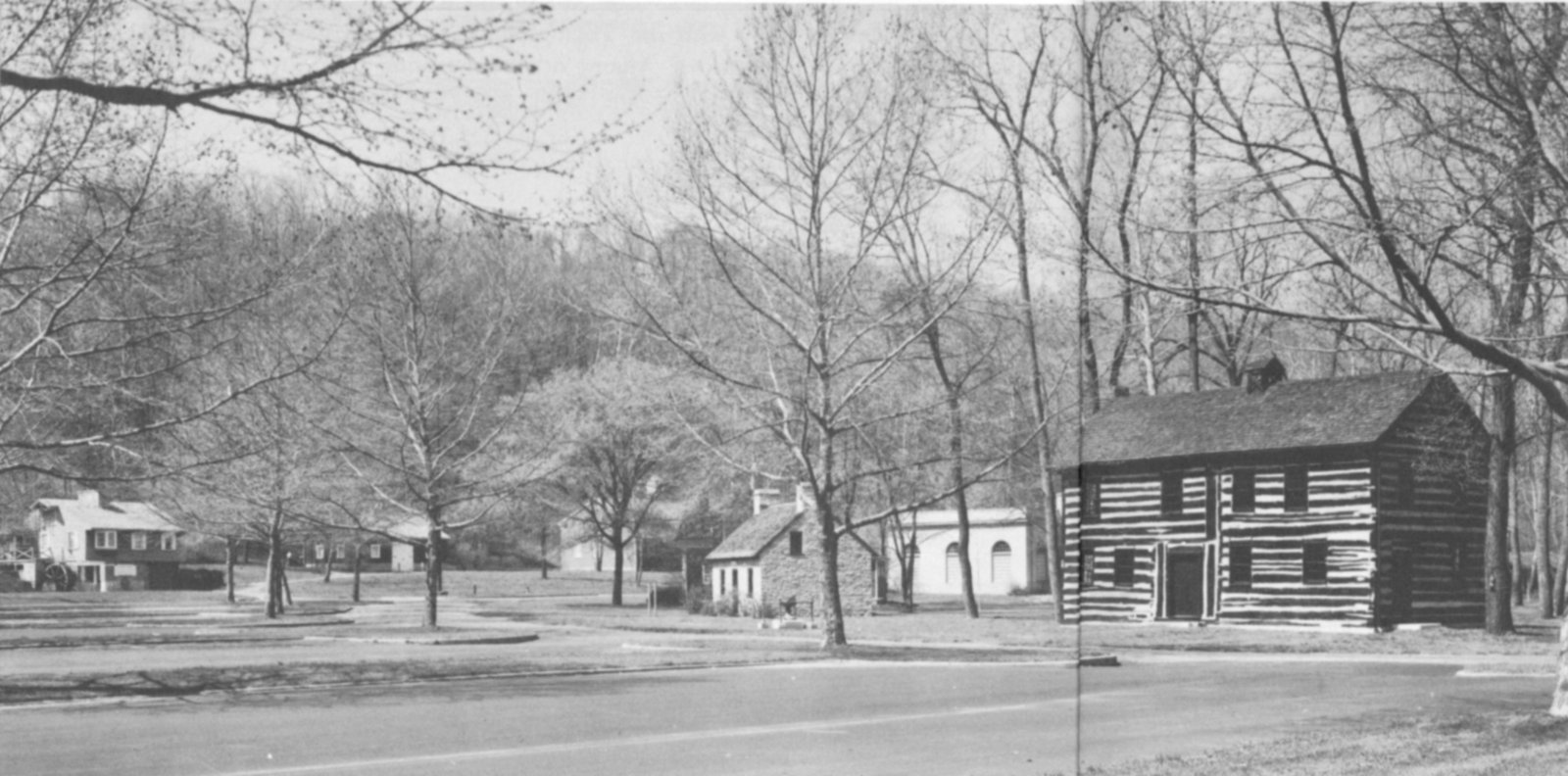
The Tavern is seen on its new site just after restoration.
Robert Edgar, like most pioneer builders, used a wide range of woods—whatever was available in the surrounding forest. Ash, hickory, walnut, beech, elm, oak, sycamore—all these are identifiable in the Tavern. The large fireplace is lined with limestone and faced with rubble stone from the river. The logs rest upon one another at the mortised corners, without attachment, although wooden pegs can be seen in mortised interior beams. Perhaps the most interesting feature of the structure is the stick and mortar chimney, typical of early houses in regions where stone was scarce and costly. Stone was plentiful by the Miami, but Edgar, no doubt handier with the adz than the trowel, stuck to the easier, faster method.
Newcom Tavern—its logs freshly mortared and stained—is as sound as it was the day, more than a century and a half ago, when Robert Edgar proudly put the final course of sticks on his primitive chimney. Here at Carillon Park, receiving the best of maintenance, this link with the past will divert many future generations of Daytonians, and remind them of their community’s heritage.
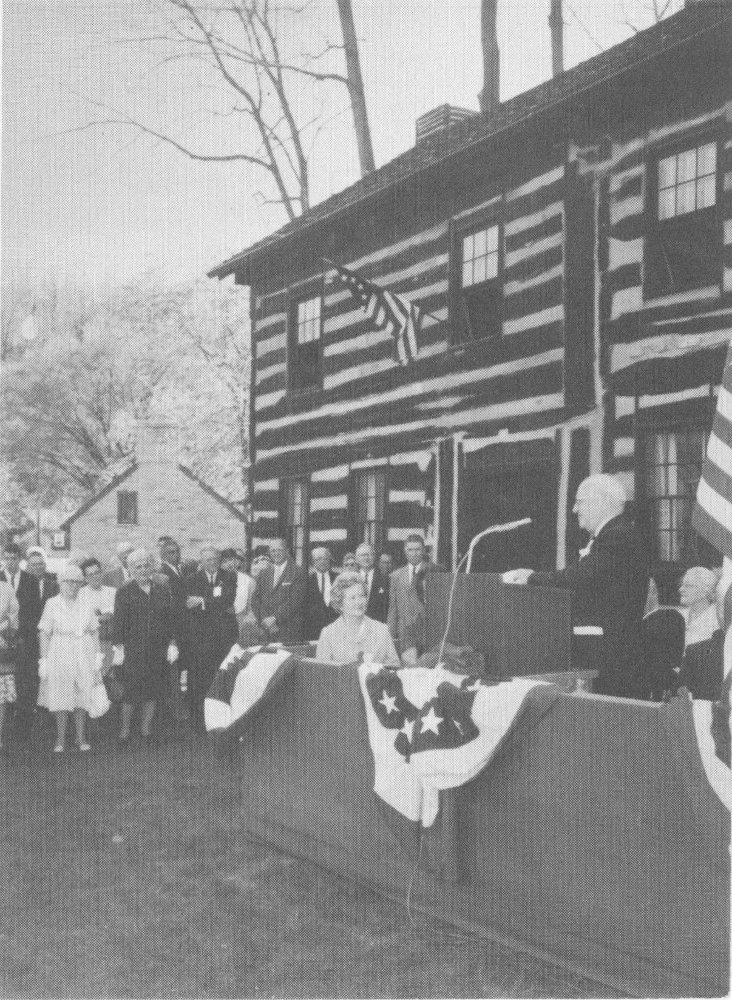
Mayor Frank Somers of Dayton speaks at the dedication ceremony on May 1, 1965.

Sundial, a memorial to the intrepid men and women who settled Dayton, stood near Newcom Tavern at Van Cleve Park, and was brought with the building to Carillon Park.
CARILLON PARK
DAYTON, OHIO
One of a series of Carillon Park booklets.
Price ten cents.